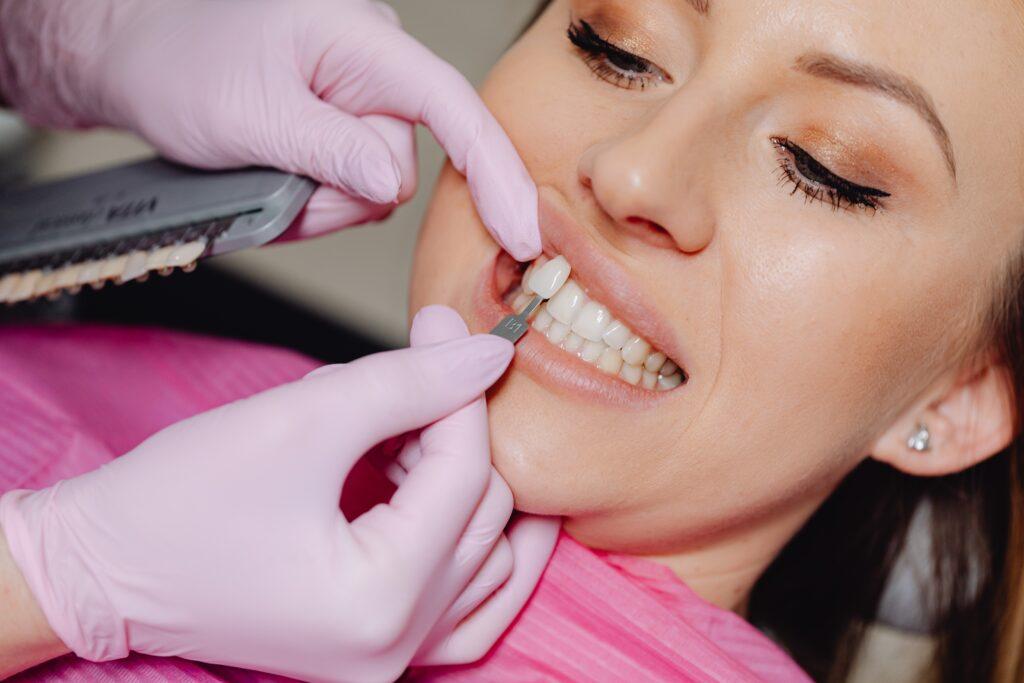Understanding Invisalign: A Comprehensive Look at the Revolutionary Orthodontic Solution
Invisalign, a groundbreaking innovation in orthodontics since its inception in 1997, has reshaped the landscape of teeth alignment treatments. It represents a discreet and convenient departure from the traditional braces, making the dream of a perfectly aligned smile more achievable than ever before.
Transparent Precision: At the heart of Invisalign’s appeal lies its nearly invisible, clear plastic aligners. These precision-crafted aligners are tailored to your unique dental anatomy, ensuring a snug fit and optimal effectiveness. Worn for an impressive 20 to 22 hours each day, they are designed to facilitate easy removal during meals and various activities, enhancing the overall convenience of treatment.
Versatility and Effectiveness: Invisalign shines brightest when addressing common orthodontic concerns such as mild misalignment and minor gaps between teeth. It offers a remarkably subtle, comfortable, and, perhaps most importantly, removable solution for those seeking a straighter and more aesthetically pleasing smile. The aligners exert gentle, consistent pressure on your teeth, coaxing them into their desired positions over time.

Exploring Dental Veneers: Unveiling the Artistry of Smile Enhancement
Dental veneers, often referred to as porcelain veneers or porcelain laminates, are a form of dental artistry designed to transform smiles by concealing a variety of dental imperfections. These ultra-thin shells, meticulously crafted from tooth-colored materials, are elegantly affixed to the front surfaces of teeth, acting as both functional shields and cosmetic enhancements.
The Artistry in Materials: Veneers come in a range of materials, with porcelain being the most favored due to its unrivaled ability to mimic the natural appearance of teeth. This material blends seamlessly with your existing dental aesthetics, creating a harmonious and undetectable result.
The Meticulous Procedure: The process of acquiring dental veneers is a blend of dental science and artistry. It commences with enamel reshaping, where a portion of the enamel is carefully filed down to ensure an ideal bonding surface for the veneers. An impression of your teeth is then meticulously captured to craft custom veneers that perfectly complement your smile. Once these veneers are ready, they are securely attached to your teeth using dental adhesive, ensuring a snug and lasting fit.
Enhancing Aesthetics: Dental veneers are particularly celebrated for their ability to address a multitude of minor dental issues. They excel in concealing discolored teeth, chipped edges, and unsightly gaps, allowing individuals to enjoy a radiant and confident smile.
Types of Veneers
Veneers are thin shells made of various materials that are custom-designed to cover the front surface of a tooth, enhancing its appearance. These veneers come in different types, each with its unique characteristics. Here’s an explanation of the most common types of veneers:
Porcelain Veneers
Porcelain veneers are the most popular and widely used type of veneers. They are prized for their natural appearance and durability. Porcelain closely resembles the look and translucency of natural teeth, making them an excellent choice for cosmetic enhancements. The process involves removing a small amount of enamel from the tooth’s front surface to accommodate the veneer. Porcelain veneers are highly stain-resistant and typically last 10-15 years or even longer with proper care.
Composite Veneers
Composite veneers are made from a resin material that is applied directly to the tooth and shaped by the dentist. Unlike porcelain veneers, composite veneers can often be placed in a single appointment, making them a quicker and more cost-effective option. However, they are not as stain-resistant as porcelain and may require more maintenance over time.
Lumineers
Lumineers are a specific brand of porcelain veneers known for their ultra-thin design. They are so thin that they often require little to no enamel removal, making them a more conservative option. Lumineers are also known for their longevity and can last up to 20 years or more. However, they may not be suitable for all cosmetic issues, particularly if significant tooth reshaping is needed.
Zirconia Veneers
Zirconia veneers are made from zirconium oxide, a strong and durable ceramic material. These veneers are highly resistant to chipping and cracking, making them an excellent choice for people with bruxism (teeth grinding) or those who need veneers on their back teeth. Zirconia veneers offer a natural appearance and excellent longevity.
Palatal Veneers
Palatal veneers are designed to cover the back surfaces of the upper front teeth. They are often used in cases where significant wear or erosion has occurred on these teeth. Palatal veneers can help restore the structural integrity of the teeth while improving their appearance.
Instant Veneers
Instant veneers, also known as chairside veneers, are a quick and cost-effective option. They are made from composite resin and can be applied in a single dental visit. While they provide an immediate cosmetic improvement, they may not be as long-lasting or stain-resistant as porcelain veneers.
Non-Porcelain Veneers
This category includes veneers made from materials other than porcelain, such as ceramic or composite resin. These veneers vary in terms of appearance and durability, so it’s essential to consult with your dentist to determine which non-porcelain option best suits your needs.

Procedure of Veneers
1. Initial Consultation
The process begins with an initial consultation with your dentist. During this appointment, you can discuss your cosmetic goals and determine if veneers are the right option for you.
Your dentist will examine your oral health, take X-rays if necessary, and discuss the different types of veneers available. This is also an opportunity to ask any questions and address concerns.
2. Treatment Planning
If you decide to proceed with veneers, your dentist will work with you to create a treatment plan tailored to your specific needs and goals. This includes selecting the type of veneers, such as porcelain or composite, and discussing the desired shade and shape of the veneers.
3. Tooth Preparation
Before veneers can be placed, a small amount of enamel must be removed from the front surface of the teeth receiving veneers. This is typically done to ensure a proper fit and prevent the teeth from appearing bulky.
Local anesthesia may be administered to ensure your comfort during this process.
After reshaping the teeth, your dentist will take impressions (molds) of your teeth. These impressions will serve as the basis for creating custom veneers that precisely fit your teeth.
4. Temporary Veneers (Optional)
Depending on the circumstances, your dentist may provide temporary veneers to protect your prepared teeth while the permanent veneers are being fabricated in a dental laboratory. Not all cases require temporary veneers.
5. Veneer Fabrication
If porcelain veneers are chosen, the impressions are sent to a dental laboratory, where skilled technicians will create custom veneers that match the desired color, shape, and size.
The fabrication process typically takes a couple of weeks. During this time, you may wear temporary veneers if provided.
6. Veneer Placement
Once your custom veneers are ready, you will return to the dental office for the final placement. Your dentist will start by ensuring the veneers’ fit and appearance. Adjustments may be made to achieve the desired results. The teeth receiving veneers will be thoroughly cleaned and etched to create a secure bond with the adhesive.
7. Adhesive Bonding
Your dentist will use a special adhesive to attach the veneers to your teeth one by one. The adhesive is cured (hardened) using a special light, ensuring a strong and durable bond.
Any excess adhesive is removed, and your dentist will make final adjustments to the veneers to ensure they align properly with your bite and look natural.
8. Final Evaluation
Your dentist will evaluate your bite, ensure the veneers meet your cosmetic expectations, and make any necessary final adjustments.
9. Post-Placement Care:
You will receive instructions on how to care for your new veneers, including recommendations for oral hygiene and any dietary restrictions. Regular dental check-ups are essential to monitor the condition of your veneers and overall oral health.

Aftercare for Veneers
After getting veneers, proper aftercare is essential to ensure their longevity and maintain the health of your teeth and gums. Here’s a detailed explanation of the aftercare steps for veneers:
1. Maintain Good Oral Hygiene
Continue to brush your teeth at least twice a day with a non-abrasive toothpaste. Use a soft-bristle toothbrush to avoid scratching or damaging the veneers. Floss daily to remove plaque and food particles from between your teeth. This helps prevent gum disease and cavities.
2. Use a Non-Abrasive Toothpaste
Choose a toothpaste that is labeled as non-abrasive. Abrasive toothpaste can damage the veneers over time by creating micro-scratches on the surface.
3. Avoid Staining Agents
Minimize your consumption of foods and beverages that can stain your teeth, such as coffee, tea, red wine, and dark-colored sauces. If you do consume them, brush your teeth or rinse your mouth with water afterward. Quit smoking or using tobacco products, as they can cause veneers to become discolored over time.
4. Wear a Night Guard (if recommended)
If you have a habit of grinding or clenching your teeth at night, your dentist may recommend wearing a night guard. Grinding can put excessive pressure on your veneers and lead to damage.
5. Attend Regular Dental Check-Ups
Schedule and attend regular dental check-ups and professional cleanings as recommended by your dentist. These visits are crucial for monitoring the condition of your veneers and overall oral health.
During check-ups, your dentist will inspect the veneers for any signs of damage, such as chips or cracks, and address any issues promptly.
6. Be Cautious with Hard Foods
Avoid biting into extremely hard foods, ice cubes, or non-food objects, as this can potentially damage the veneers or dislodge them.
Cut hard foods into smaller, bite-sized pieces to reduce the risk of exerting excessive force on the veneers.
7. Maintain a Balanced Diet
Consume a well-balanced diet rich in fruits, vegetables, and dairy products. These foods can help maintain the health of your natural teeth and gums. Calcium and vitamin D are essential for strong teeth and may also benefit the longevity of your veneers.
8. Handle Veneers with Care
Be mindful when using your teeth as tools to open packages or bite into objects. Veneers are durable but not indestructible. If you engage in sports or activities that could risk injury to your mouth, consider wearing a mouthguard for protection.
9. Address Any Issues Promptly:
If you experience any discomfort, pain, or notice changes in the appearance of your veneers, contact your dentist immediately. Early intervention can prevent more extensive problems.
10. Follow Dentist’s Recommendations:
Always follow your dentist’s advice and recommendations regarding the care and maintenance of your veneers. They may have specific instructions based on your individual case.

Invisalign vs. Veneers: Choosing the Right Cosmetic Dental Solution
When it comes to enhancing your smile, you have several cosmetic dentistry options at your disposal. Invisalign and veneers are two popular choices, but it’s crucial to understand that they address different dental concerns. Consulting with an orthodontist is the best way to receive personalized guidance for your specific needs.
Determining Your Primary Concerns
To determine which treatment is right for you, it’s essential to identify your primary dental concerns:
Appearance
Are your main concerns related to the aesthetics of your teeth, such as discoloration, chips, cracks, or gaps?
Malocclusion
Are you dealing with bite issues, where your teeth are not correctly aligned, leading to an imperfect smile due to malocclusion?
If your primary concern is appearance-related, both Invisalign and veneers can be considered. However, if malocclusion is your main issue, Invisalign is often the preferred choice. For other concerns, such as crooked teeth, alternative treatment plans may be explored.
Comparing Invisalign and Veneers
Invisalign
Pros:
- Clear Aligners: Invisalign uses clear aligners that are nearly invisible when worn, ensuring a discreet treatment process.
- Fixes Malocclusion: Invisalign is highly effective for correcting bite issues and repositioning teeth.
- Minimal Filing: Unlike veneers, Invisalign does not require extensive filing down of tooth enamel, especially in cases of crowding.
- Permanent Results: Invisalign offers a permanent solution to malocclusion.
- Preserve Natural Teeth: It maintains the integrity of your natural teeth.
- Few Food Restrictions: Invisalign wearers have minimal food restrictions, as the aligners can be easily removed for meals.
Cons:
- Longer Treatment: Invisalign treatment may take a longer period, often ranging from 6 to 20 months.
- Maintenance: Requires diligent maintenance and consistent wear (20-22 hours daily).
- Cost: The cost of Invisalign can be higher compared to veneers.
- Limited in Complex Cases: Invisalign may not be suitable for highly complicated orthodontic issues.
Veneers:
Pros:
- Short Treatment Time: Veneer placement typically involves four dental visits, offering a quicker cosmetic solution.
- Improves Tooth Appearance: Ideal for fixing minor tooth appearance issues, including whitening teeth.
- Minimal Food Restrictions: Veneers do not impose strict food restrictions.
- Non-Permanent: Veneers are not permanent and can be replaced if needed.
Cons:
- Does Not Fix Malocclusion: Veneers do not address bite issues or reposition teeth.
- Enamel Filing: The process involves some enamel reshaping, which is not reversible.
- Possible Staining: The edges of veneers can potentially become stained over time.
| Invisalign | Veneers | |
|---|---|---|
| Pros | ||
| Clear Aligners | Clear Invisalign aligners are nearly invisible. | N/A (Veneers are visible but look natural.) |
| Fixes Malocclusion | Effective for correcting bite issues and alignment. | N/A (Primarily used for cosmetic enhancements.) |
| Minimal Filing | Requires less enamel reshaping, especially in crowding cases. | Enamel reshaping is part of the process. |
| Permanent Results | Offers a permanent solution to malocclusion. | N/A (Enhances the appearance of existing teeth.) |
| Preserves Natural Teeth | Maintains the integrity of your natural teeth. | N/A (Covers the front surfaces of teeth.) |
| Few Food Restrictions | Minimal food restrictions; aligners can be removed for meals. | Few food restrictions; regular diet can be maintained. |
| Cons | ||
| Longer Treatment | Treatment duration can range from 6 to 20 months. | Shorter treatment time, typically four dental visits. |
| Maintenance | Requires consistent wear (20-22 hours daily) and diligent maintenance. | Standard oral care practices, occasional replacement. |
| Cost | Costs may be higher compared to veneers. | Costs vary but are generally lower than Invisalign. |
| Limited in Complex Cases | May not be suitable for highly complicated orthodontic issues. | N/A (Primarily addresses cosmetic dental concerns.) |
| Impact on Enamel | Requires some enamel filing; not reversible. | Involves enamel reshaping as part of the process. |
| Possible Staining | N/A (Aligners are clear plastic and don’t stain.) | Edges of veneers can potentially become stained. |
Key Differences between Invisalign and Veneers
Treatment Time
The period of Invisalign treatment depends on each suitable candidate and their dental case. For my case, my estimated treatment time is 16-18 months. For more complex cases, it might take longer. It could be anywhere between 6 to 20 months on average. Small movements of teeth take time for the teeth to get to the proper position.
On the other hand, dental veneers take a shorter time. Usually, patients visit the dental office four times to get the veneers on their teeth. It is much easier and more convenient to get the veneer treatment.
Teeth Repositioning
To fix malocclusion, which is the imperfect positioning of your teeth, Invisalign and the traditional metal braces are your options. Although these orthodontic treatments take a longer time to get the best result, they are permanent repositioning tools for your teeth.
In contrast, dental veneers are not permanent and do not move your teeth to a new position. Porcelain veneers cover the current teeth and give a better look to the front of the teeth and give you a smile makeover.
Impact on Current Enamel Level
Both Invisalign and dental veneers require some filing down of your enamel, meaning that your teeth cannot go back to where they were before the treatment. That is why making the right decision is so critical in your orthodontic journey.
Maintenance
Invisalign treatment will get you the best result when you commit to taking good care of your teeth and invisible aligners. You need to take off the aligners for eating and drinking while you try to wear the aligners 20 to 22 hours per day. This dental routine would help you to keep up with good oral hygiene. Since the aligners are onto your permanent teeth, taking good care of both teeth and the aligners would be beneficial to you.
Dental veneers also require good oral care. When thin pieces of porcelain are attached to your teeth, you need to brush and floss as you have before. There might be some breaking and chipping happened to the thin shells of porcelain. The porcelain layers can get stained over some period of time as well. Then, you can get them replaced with new ones.
For food and drink intake, just for general dental care, it’s better to avoid hard foods and dark-colored drinks. Invisalign and dental veneers do not have any specific food restrictions for their patients.
Cost
Invisalign can cost anywhere between $4000-10000. Dental veneers are $250-3000 per tooth.
| Invisalign | Veneers | |
|---|---|---|
| Treatment Time | Duration varies, potentially longer. | Quicker solution, fewer dental visits. |
| Teeth Repositioning | Suitable for repositioning teeth and malocclusion. | Enhances appearance of existing teeth. |
| Impact on Enamel | Requires some enamel filing; not reversible. | Involves enamel filing as part of the process. |
| Maintenance | Demands consistent wear and maintenance. | Requires standard oral care, occasional replacement. |
| Cost | Cost varies; can be more expensive. | Generally lower cost, but varies by individual case. |
Invisalign vs. Dental Veneers: Choosing the Ideal Option for You
Cosmetic dentistry stands as a remarkable solution for addressing various teeth-related aesthetic concerns. However, these concerns may extend beyond the desire for a captivating smile; they could encompass the broader spectrum of dental health, encompassing factors like the preservation of natural tooth enamel, tooth repositioning, and overall oral well-being. Therefore, it is paramount to consider the comprehensive aspects of your dental condition, whether apparent or latent.
It is crucial to understand that there is no one-size-fits-all answer when it comes to determining the superior choice for enhancing your dental aesthetics. Each individual’s dental needs are unique, and what suits one person might not be the ideal solution for another. To embark on your journey towards achieving your smile aspirations, teeth alignment, and maintaining oral health, the pivotal first step is to seek consultation from reputable orthodontic experts within your local community.
During your initial consultation with orthodontic professionals, a thorough assessment of your natural teeth will take place. This assessment will lead to a personalized recommendation that aligns with your overall oral health objectives. While these dental appointments might initially evoke feelings of apprehension, rest assured that as you progress, you will become increasingly at ease and self-assured in your pursuit of dental well-being.




Pingback: Best Invisalign Alternatives: Explore Orthodontic Options - Bite Smile Way